Harvesting, Curing, and Storing Onions
This post may contain affiliate links, which means that I may receive a commission if you make a purchase using these links. As an Amazon Associate I earn from qualifying purchases.
Storage onions are a variety of onions that will last when stored in a cool location through the winter months. Learn which varieties to grow for food storage, plus tips on harvesting, curing, and storing onions for winter food storage.

I grow several varieties of onions in my vegetable garden each year, including quick-maturing scallions and other varieties for fresh eating.
However, the majority of onions that I grow are storing onions meant to last through the winter months until the next growing season. Stored onions add delicious flavor to winter soups, bone broths, chili, stews, and roasts.
Benefits of Properly Harvesting, Curing, and Storing Onions
Growing storage onions takes time, effort, and precious garden space. Losing your harvest to spoilage or sprouting means wasted money and labor. Knowing when onions are mature and ready to harvest, how to cure onions, and how to store onions will help you get the maximum return on your time and effort, providing a steady supply of homegrown onions throughout the off-season.
Properly harvesting, curing, and storing onions is essential for maintaining their quality and ensuring they last through the winter months:
- Prevents Spoilage: One of the main risks of improper storage is spoilage. Onions that are not fully cured or stored in the right conditions can become moldy or rot. Moisture is a primary enemy, as it encourages the growth of mold and bacteria, leading to decay. Spoiled onions not only become inedible but can also spread mold to other stored onions, compromising your entire stock.
- Discourages Sprouting: When stored properly, onions are less likely to sprout. Warm temperatures and humidity can cause onions to develop green shoots from the bulb. Although sprouted onions are still safe to eat, their texture and flavor may change, and they can become bitter and less suitable for cooking. Moreover, sprouted onions have a shorter shelf life.
- Preserves Flavor: Onions stored properly can maintain their robust flavor. The key to preserving their taste is maintaining the right environment—cool, dark, and dry. Exposure to light and warmth can cause onions to lose their pungency and sweetness, leading to bland or off-tasting results in your culinary dishes.
By understanding and implementing the correct harvesting, curing, and storage methods, you can avoid common pitfalls and enjoy the full benefits of your onion crop. Properly storing your onion harvest protects your investment of time, effort, and resources. By preventing spoilage and sprouting, you ensure a steady supply of homegrown onions for months to come.
How to Choose Onions to Grow for Food Storage
When choosing onions to grow for winter storage, it’s important to grow varieties known for their long-term storage capabilities. It’s also important to consider your regional climate, as different types of onions perform better in various conditions:
Northern Climates (Zones 6 and Cooler):
In northern regions, long-day onions are the best choice. These onions are triggered to bulb when daylight lasts 14 to 16 hours. Varieties such as Patterson, Cortland, and Redwing are well-suited for these areas. These onions are typically started indoors in late winter and transplanted outside in early spring.
Southern Climates (Zones 7 and Warmer):
In southern regions, short-day onions are more suitable. These onions begin bulbing when daylight lasts 10 to 12 hours. Varieties such as Texas Sweet or Southern Belle Red are better choices for these areas. These onions are often planted in the fall and harvested in late spring.
Intermediate Climates (Zones 6-7):
In intermediate zones, intermediate-day onions, such as Candy or Superstar, can be a good option. These onions require about 12 to 14 hours of daylight to bulb and can adapt to a range of growing conditions.
Here in the north, Patterson, Cortland, Rossa Di Milano, and Redwing are my staple onions for long-term storage over winter. These varieties work wonderfully for winter soups, chili, stews, and roasts.
- Patterson onions are renowned for their excellent storage qualities, often lasting well into the spring. They have a firm texture and a strong, pungent flavor, making them ideal for various dishes. These yellow onions also resist diseases, contributing to their longevity.
- Cortland onions are another great storage choice. They have a slightly milder flavor than Patterson, with a crisp texture that holds up well over time. These yellow onions are known for their uniform size and shape, making them easy to store and handle.
- Rossa Di Milano is a red onion variety celebrated for its robust flavor and excellent storage potential. These onions are slightly sweet and have a firm texture, which makes them perfect for adding color and flavor to salads, salsas, and cooked dishes. They store well, typically lasting through the winter months.
- Redwing onions are known for their beautiful deep red color and excellent storage life. Their strong, pungent flavor mellows when cooked, making them versatile for both raw and cooked applications. Redwing onions can be stored for several months without losing their quality.
Onions are the first seeds I sow for the approaching growing season. I plant them indoors under grow lights in January or February, so they have plenty of time to develop before forming bulbs.
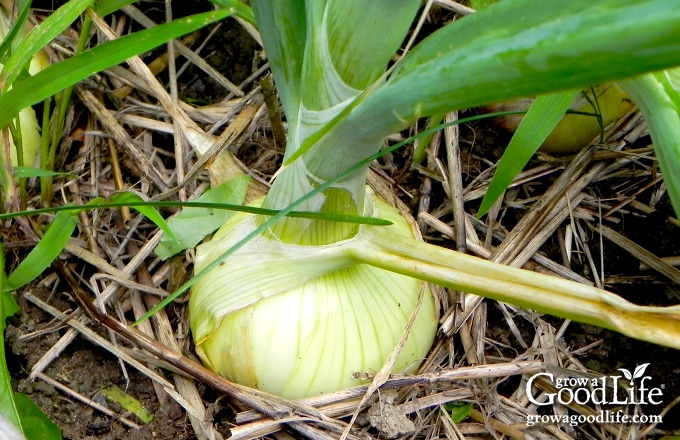
Did you know that each hollow, green leaf represents a ring in the onion? Strong, healthy foliage growth before the bulbs form results in larger onions when mature and ready for harvesting.
You can also plant onions from transplants, or onion sets purchased online or at your local garden center. Here in the north, onion seedlings or onion sets are planted in the garden in early spring, usually in April and grow all summer long. You can learn more about growing onions from seeds, sets, and transplants in our growing guide: How to Grow Onions.
By choosing the right onion varieties for your region, you can ensure a bountiful harvest that stores well through the winter months, providing delicious and nutritious additions to your meals.
When to Harvest Onions
Onions can be harvested at any time for fresh eating, but for storing onions, it is best to allow them to mature fully. Mature onions will have larger bulbs and better storage capabilities.
Onions will let you know when they are finished growing. You will start to see the tops flop over, and the onion’s foliage will bend over at the stem. This indicates that the plant has stopped directing energy to the foliage.
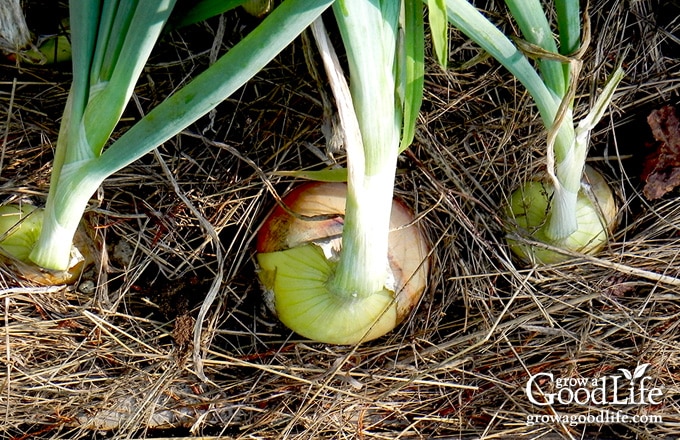
Initially, I will spot one or two plants flopping. Eventually, the rest will follow. This typically occurs in the first few weeks of August in my Maine garden, but the timing can vary depending on your region and specific varieties.
Once the tops fall over, stop watering the onions and wait for a dry period to harvest. This helps the bulbs start the curing process even before they are pulled from the ground.
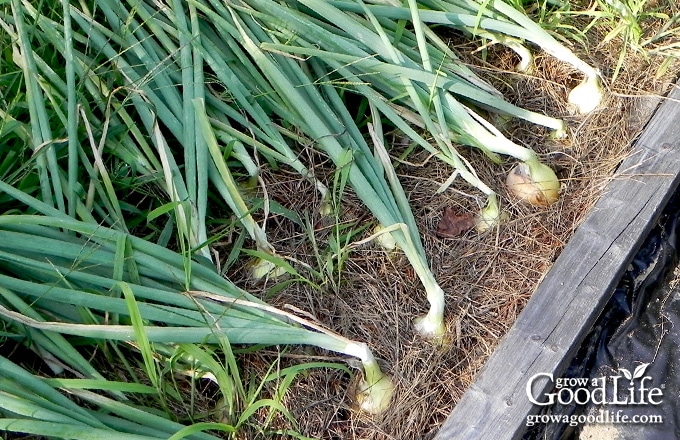
How to Harvest Onions
Once you have determined that your onions are finished growing, it is time to harvest them. Wait for a dry period and overcast day to reduce damaging the bulbs as you work. Then follow these tips to harvest your onions:
- Wait for Dry Soil: It’s important to ensure the soil is dry when you harvest. Wet soil can cling to the bulbs, making them more difficult to cure properly and increasing the risk of rot. If it has rained, wait until the soil has dried out several days before harvesting.
- Choose an Overcast Day: Aim to harvest onions on an overcast day. This reduces the risk of the bulbs being damaged by the sun as you work. If the weather is sunny, be sure to move the onions to a shady spot as soon as possible.
- Loosen the Soil: Use a digging fork to carefully loosen the soil around the onions. Insert the fork several inches away from the bulbs to avoid puncturing them. Gently lift and loosen the soil to make it easier to pull the onions out.
- Pull the Onions: After loosening the soil, grasp the onion around the neck, just above the bulb, and gently pull it from the ground. Be careful not to bruise the bulbs, as any damage can reduce their storage life.
- Initial Drying: If the sky remains cloudy after harvesting, you can spread the onions out on the garden fence or a similar structure to allow any remaining soil to dry and be shaken off. If the sun is out, move the onions to a dry, shady area out of direct sunlight to prevent sunscald.
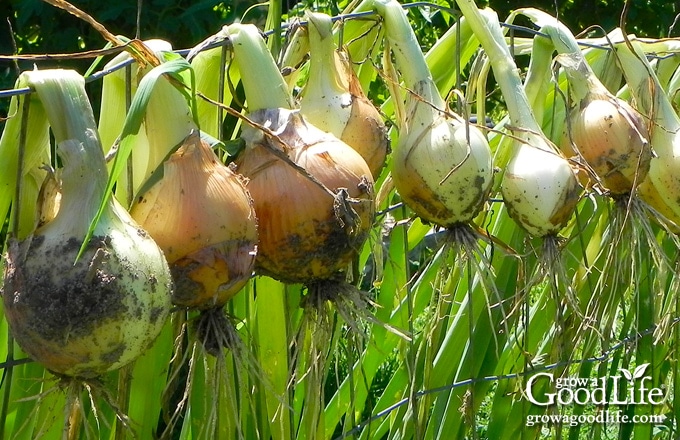
Curing Onions
Curing onions allows the outer layers to dry out and tighten, forming a protective wrapping around the bulb to help preserve them through winter. Here are the steps for curing onions:
Select the Right Location
Choose a shaded, dry, and sheltered place for curing. Ideal curing conditions are in a warm and breezy location, around 75-80°F with low humidity. Direct sunlight can cause sunscald, while high humidity can lead to mold and rot. Consider curing your onions in a shed, garage, or covered porch if your weather is dry.
Spread Out the Onions
Lay the onions out in a single layer on a clean, dry surface. Good airflow is essential, so consider using wire racks, screens, or mesh trays that allow air to circulate around each bulb. Do not stack onions during the curing process, as this can restrict airflow and lead to uneven curing or mold development.
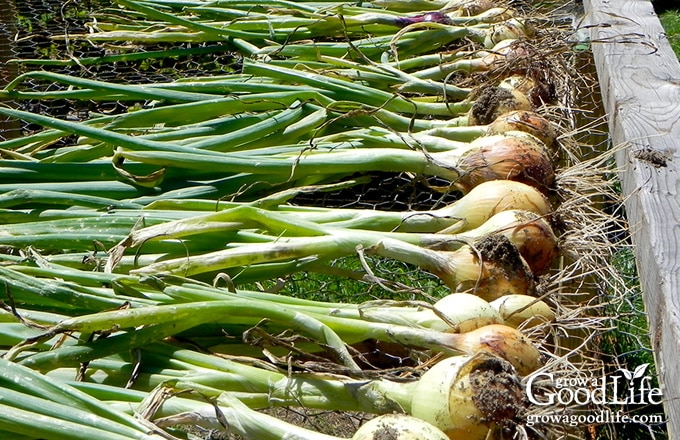
Alternatively, you can cure onions by hanging them. Use a piece of string or old pantyhose, place an onion in and tie a knot above it, then add another onion and tie another knot, creating a chain of onions. Hang these chains in a well-ventilated, shaded area.
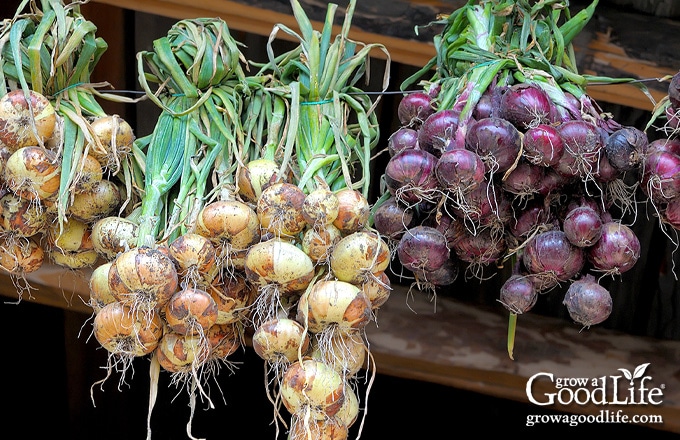
Maintain Good Airflow
Ensure adequate air circulation around the onions. This helps them dry evenly and prevents the build-up of moisture that could cause rot. In areas with high humidity, consider using fans to improve airflow.
Inspect the onions regularly during the curing process. Shift them around for even curing, and remove any onions that show signs of mold, rot, or sprouting to prevent them from affecting the others.
Allow Plenty of Curing Time
Curing can take several weeks to a month, depending on the humidity level and the size of the onions. Onions are fully cured when their outer skins are papery, the necks are constricted, and the foliage has completely shriveled and turned brown.
To check if your onions are fully cured, cut the stem of one onion about an inch from the bulb. The center of the cut area should be dry all the way through and show no signs of green. If you see green, allow the onions more time to cure, checking weekly until fully dry.
How to Store Onions
After curing your onions, it’s important to store them properly to maintain quality and extend their shelf life through the winter months. Here are some tips for storing onions:
Preparing Onions for Storage
Once the onions are fully cured, I like to take the bundles back outside for cleaning and trimming before storing them.
Use scissors to cut the stems cleanly an inch or two from the bulbs, and remove any remaining roots to prevent them from harboring moisture or pests.
Gently brush off any additional soil clinging to the papery skin. It’s okay if the outer layer of skin falls off during this process; just avoid damaging the inner layers.
As you clean and trim the onions, examine each one carefully. Look for any signs of blemishes, bruising, or damage. Any onions with imperfections should be set aside for immediate use, as they will not store as well.
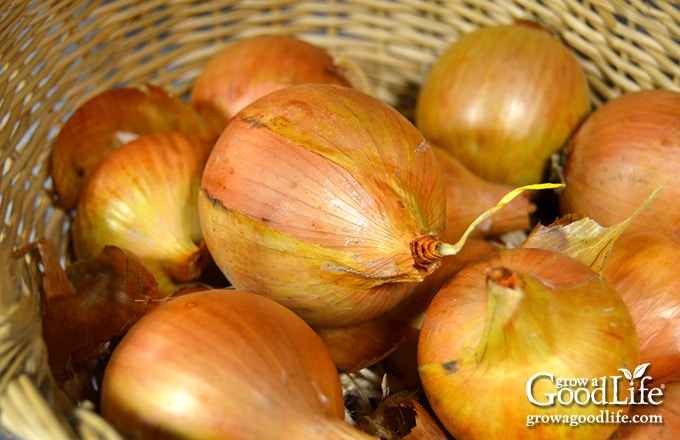
Find an Ideal Storage Location
You don’t need a root cellar to store onions for winter successfully. With the right conditions and a bit of creativity, you can find alternative storage locations that maintain the ideal temperature, humidity, and darkness for long-term onion storage.
- Temperature: Onions store best in a cool place at temperatures between 35-40°F. These cool temperatures slow down the onions’ metabolic processes, extending their shelf life. While a root cellar provides naturally cool temperatures, other options include an unheated basement, garage, or closet.
- Humidity: Low humidity helps to prevent onions from sprouting or rotting. The ideal humidity level is around 65-70%. Too much moisture can encourage mold and decay. Ensure proper ventilation in your storage area to promote air circulation and prevent humidity build-up. Consider using a dehumidifier in your storage space to reduce excess moisture and maintain the ideal humidity level.
- Darkness: Store onions in a dark place to prevent them from sprouting. Light can trigger the growth of green shoots. Place onions in baskets or bins covered by a dark towel to shield them from light exposure but allow good ventilation.
In addition, store onions separately from ethylene-producing fruits and vegetables and those sensitive to ethylene gas to maintain the quality and freshness of your storage crops. Avoid storing onions near apples, pears, and other root veggies such as potatoes, carrots, beets, and turnips. You can learn more in this article: Crops to Stock Up on for Root Cellar Food Storage.
Storage Methods
Here are effective ways to store onions while ensuring adequate ventilation and airflow:
- Baskets: Store onions loosely in baskets or a well-ventilated container that allows for good airflow. Do not pile onions too deeply so air can circulate around each bulb.
- Mesh Bags: Hanging onions in mesh bags allows air to circulate and helps keep them dry. Hang the bags in a cool, dark place.
- Wire Shelves: If you have wire or slatted shelves, these can be used to store onions in a single layer, ensuring good airflow around each bulb.
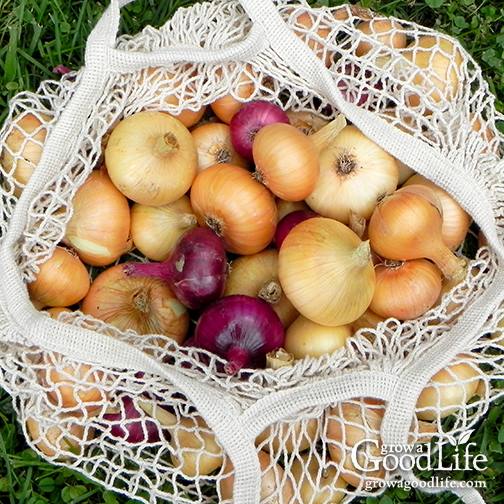
How Long Do Onions Last?
Garden-grown storage onions that have been properly cured and stored can have an impressive shelf life. Under ideal conditions, onions can last 6 to 9 months or even longer.
Different onion varieties and storage conditions will affect their shelf life. Patterson and Redwing usually last the longest for me and begin to get soft or sprout around April.
While onions are known for their long shelf life, it is important to check them periodically for any signs of sprouting, softening, or mold. Remove any onions showing signs of spoilage to prevent them from affecting others.
If caught early, onions that are starting to sprout or soften can still be used. You can use them in cooking, freeze them for later use, or dehydrate them into onion flakes or powder.
Onion Preservation Alternatives
- Freezing Onions: Chop and freeze onions to extend their usability. Frozen onions can be used directly in cooking without the need for thawing.
- Dehydrating Onions: Dry onions to make onion flakes or onion powder. This is a great way to preserve any onions that are starting to degrade.
- Pickling Onions: Consider pickling onions as another preservation method. Pickled onions add a tangy flavor to salads, sandwiches, and other dishes.
By following these detailed steps for harvesting, curing, and storing your onions, you can ensure they remain in excellent condition for months. Properly stored onions will provide you with a reliable supply of flavorful and nutritious bulbs throughout the winter, making all your hard work in the garden worthwhile.
You May Also Like:
- 9 Crops to Grow for Food Storage
- How to Grow Onions
- Benefits of Crop Rotation in the Garden
- How to Make Chicken Stock from Scratch
Good planning is key to a successful vegetable garden
Whether you are new to growing your own food or have been growing a vegetable garden for years, you will benefit from some planning each year. You will find everything you need to organize and plan your vegetable garden in my PDF eBook, Grow a Good Life Guide to Planning Your Vegetable Garden.


I like to chop up some of my onions and pre measure out and put in zip lock bags and pop in the freezer. That way when I want onions in a dish but am short on time I just dump the pre measured onions in while my meat is cooking and they are perfect! Huge time saver and great way to store those extra onions that are reaching the end of their shelf life.
Very helpful information for starting onion seeds.
I dehydrate my onions. It seems to consume the least time and they last so much longer.
Great post! Looking forward to getting our onions harvested in the next week. Thank you!
I’m determined to grow onions next year. Thanks for sharing a great how-to on the Homestead Blog Hop!
Great post! We’ve been getting loads of onions from our CSA this season and I’ve been thinking about how I want to save them. This has been very helpful!
Thank you,
Christine
Fantastic tips & beautiful pictures. Hanging them on the fence to cure is a genius idea! I’m visiting from Our Simple Homestead blog hop.
Thanks
Angie
I planted 7 varieties of onion, leeks, and two garlic varieties…We love all of these so much!! My question is–if the tops flop over from little feet should they be harvested or will they still grow? Foliage still green and onions pretty small still. Let me know your thoughts. Thanks!
Krista, They may still grow. I would let them go for a while and wait until the foliage begins to turn brown.
My mother braided her onions instead of cutting the neck once they were cured. She hung them from nails around the edge of the store room in our basement. They can then be used by cutting them from the braid, bottom onions first.
Laura, I love how pretty braided onions look. Plus it would be much easier to keep an eye on them to check for any rotting.
What a fabulous article! Thank you! I always grow a lot of onions and did NOT know how to cure or store, so many many rotted.